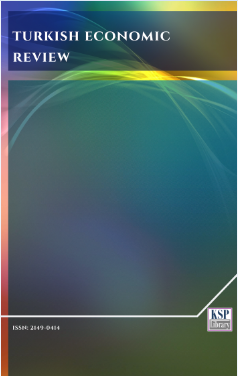Empirical analysis of non economic determinants of private investment in Pakistan (1969-2016)
Abstract
Abstract. Private and public investment has own contribution to the growth process of an economy. Private investment is very crucial for economic growth and poverty reduction. Whereas, public investment contributes positively to economic growth through enhancing the productivity of private investment (Ang, 2009). Various empirical studies in developing countries showed that economies led by the private sector achieved better economic performance than the one led by the state. Pakistan has a very sluggish growth in private sector which is a major cause of slow economic growth in the country. So, it is very important to explore the factors which can stimulate the private sector investment in Pakistan. Therefore, this research is designed to find out major non economic determinants which can stimulate or hinder the private investment in Pakistan. Studies on non economic determinants are not sufficient in Pakistan so this study will fill the Gap. In this study for estimation, ARDL approach was applied on time series secondary data (i.e. from 1969 to 2016). The empirical evidence confirms that there exists a long run relationship exist between dependent and independent variables in the model. Furthermore, in the long run, corruption, political instability and violence have significantly negative impact on private investment. Results also suggested that in the short run, the disequilibrium is rapidly adjusted. Based on study results, it is recommended that policy makers develop more effective policies of good governance to improve the private investment.
Keywords. Private investment, Corruption, Political instability, Violence, Time series data, Pakistan.
JEL. D72, D73, E20, E22.
Keywords
References
Abel, A.B., & Bernanke, S. (2006). Macroeconomics, Fifth Edition, Pearson Addison Wisely.
Ang, J.B. (2009). Do public investment and FDI crowd in or crowd out private domestic investment in Malaysia?, Applied Economics, 41(7), 913-919. doi. 10.1080/00036840701721448
Asian Development Bank Report, (2008). Private sector assessment of Pakistan 2008, [Retrieved from].
Benfoa, M., & Sanchez-Robes, B. (2003). Foreign direct investment, economic freedom, and growth: new endence from Latin America, European Journal of Political Economy, 19(3), 529-545. doi. 10.1016/S0176-2680(03)00011-9
Bint-Aijaz, M., & Ellahi, N. (2012). Public- private investment and economic growth in Pakistan, Paksitan Development Review, 51(4), 61-78.
Carmignani, F. (2007). Economic and socio-political determinants of defacts monetary institution and inflationary outcomes, 8, 15-25.
Dearden, S.J.H. (2000). Corruption and economic development, DSA European Development Policy Study Group Discussion Paper, No.18. [Retrieved from].
Government of Pakistan, Ministry of Finance, (1993-1994). Economic Survey of Pakistan.
Government of Pakistan, Ministry of Finance, (2007-2008). Economic Survey of Pakistan.
Government of Pakistan, Ministry of Finance, (2011-2010). Economic Survey of Pakistan.
Gujarati, D.N., & Porter, D.C. (2009). Basic Econometrics, Fifth Edition, McGraw Hill.
Hussain, Z. (2014). Can political stability hurt economic growth, Submitted to World Bank reports on 06-6-2014, [Retrieved from].
Hyder, K., & Masood, A.Q. (2003). Why private investment in Pakistan has collapsed and how it can be restored. Lahore Journal of Economics, 9(1), 107-128.
Investment in Pakistan Report, (2010). KPMG Tasser Hadi & co, chartered accountants, Page #1, [Retrieved from].
Naqvi, N.H. (2002). Crowding-in or crowding-out? Modelling the relationship between public and private fixed capital formation using co-integration analysis: The case of Pakistan 1964-2000. Pakistan Development Review, 41(3), 255-276.
Oladipot, B. (2007). Private investment and political instability evidence from Nigeria, International Journal of Applied Economatrics and Quantitative Studies, 4(2), 45-68.
Shahzad, S.J.H., Zakaria, M., Rehman, M.U., Ahmed, T., & Fida, B.A. (2015). Relationship between FDI, terrorism and economic growth in Pakistan: Pre and Post 9/11 analysis, Social Indicators research, 127(1), 179-194. doi. 10.1007/s11205-015-0950-5
Shabir, G., & Anwar, M. (2007). Determinants of corruption in developing countries, HWWI Research Paper, [Retrieved from].
Shehnazi, K., & Garagoz, S.A. (2014). The impact of corruption on private domestic sector investment, case study of selected developing countries, International Journal of Social Sciences and Education, 4, 19-31. doi. 10.4172/2162-6359.1000388
Wei, S.J. (1997). Why is corruption so much more taxing than tax? Arbitrariness kills, NBER Working Paper, No.6255. doi. 10.3386/w6255
Vaish, M.C. (1976). Macro Economic Theory, Third edition VIKAS Publication New Delhi.
DOI: http://dx.doi.org/10.1453/ter.v5i3.1735
Refbacks
- There are currently no refbacks.
.......................................................................................................................................................................................................................................................................................................................................
Turkish Economic Review - Turk. Econ. Rev. - TER - www.kspjournals.org
ISSN: 2149-0414
Editor: [email protected] Secretarial: [email protected] Istanbul - Turkey.
Copyright © KSP Library




